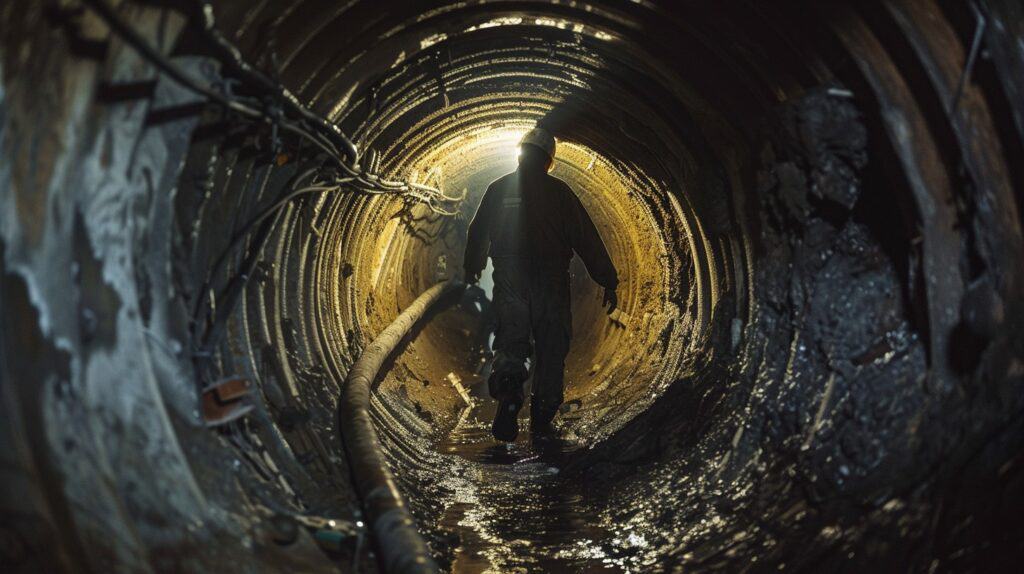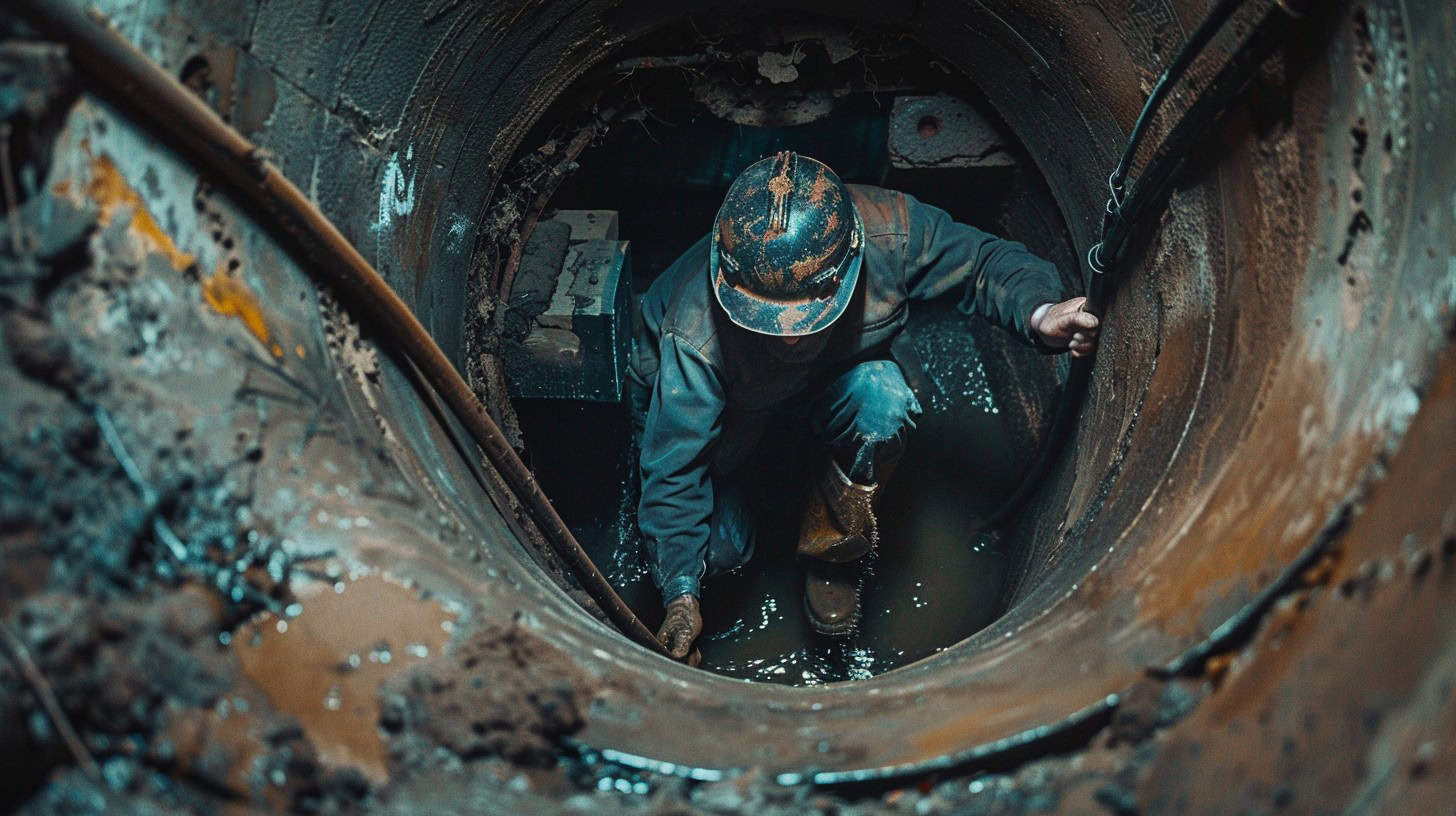Unclogging a main sewer line can save homeowners up to $200 in repair costs. Foul odors, fluctuating toilet water levels, and gurgling drains signal a potential blockage. 3 This guide offers 6 easy fixes to clear your sewer line without breaking the bank.
As a licensed plumber with 15 years of experience, I’ve tackled countless sewer line clogs. I’ll share proven DIY methods and when to call a pro. Learn how to keep your pipes flowing smoothly and avoid costly repairs. 1
Key Takeaways
Main sewer line clogs can be identified by slow drains, gurgling noises, foul smells, and water backups in multiple fixtures.
DIY fixes like using boiling water, plungers, vinegar and baking soda, or a wet/dry vacuum can often clear minor to moderate clogs for under $25.
For persistent blockages, tree root intrusions, or pipe damage, professional plumbers should be called to inspect and repair the sewer line using specialized equipment.
Installing drain guards, conducting regular drain cleaning, and proper waste disposal help prevent future sewer line clogs.
Annual professional sewer line inspections are recommended to catch issues early and avoid costly repairs.
Table of Contents
Identifying Symptoms of a Main Sewer Line Blockage

A clogged main sewer line can wreak havoc on your home’s plumbing system. Watch out for these telltale signs – they’re your first clue that trouble’s brewing underground.
Slow Draining in Sinks and Toilets
Slow-draining sinks and toilets signal potential main sewer line troubles. Water lingers longer than usual, refusing to disappear quickly down the drain. 2 This issue often affects multiple fixtures simultaneously, indicating a larger problem beyond individual drains.
Gurgling noises might accompany the slow drainage, hinting at air trapped in the pipes. 1
A slow drain is your home’s way of crying for help.
Persistent slow drains demand immediate attention to prevent costly main sewer line repairs. Ignoring these symptoms can lead to complete blockages, water backups, and unsanitary conditions. 1 Homeowners should act promptly, using drain cleaners or plumbing snakes to address minor clogs. For recurring issues, professional inspection of the sewer system becomes crucial. 2
Gurgling Noises from Drains
Gurgling noises from drains signal trouble in your sewer line. These sounds occur when air bubbles struggle to escape through water-filled pipes. You’ll often hear them in multiple locations – kitchen sinks, showers, and toilets.
This widespread gurgling indicates a main line issue, not just a problem with a single fixture. 3
Don’t ignore these noises. They’re early warnings of potential sewage backups and water damage. Turn off your water supply immediately if you hear persistent gurgling. This quick action can prevent flooding and costly repairs. 4 Gurgling, combined with slow draining and foul odors, demands prompt attention from a professional plumber.
Foul Smells Emerging from Drains
Foul odors wafting from drains signal potential main sewer line clogs. These unpleasant smells often stem from trapped sewage or wastewater, unable to flow properly through the system.
Persistent stench indicates a serious issue requiring immediate attention. Professional plumbers use video inspection cameras to pinpoint the exact source of these odors, ensuring targeted solutions. 5
Enzyme cleaners, applied monthly, effectively prevent foul smells from developing in drains. These natural products break down organic matter, keeping pipes clear and odor-free. Regular maintenance with these cleaners can save homeowners from costly repairs down the line. 6 Next, let’s explore the steps to clear a main sewer line clog.
Water Backup in Various Drains
Water backup in multiple drains signals a serious main sewer line blockage. 7 Toilets, sinks, and showers may all start to gurgle or fill with water simultaneously. 2 This issue often stems from corrosion in iron pipes, heavy rainfall, or invasive tree roots.
Left unchecked, it poses significant health risks due to harmful bacteria and airborne contaminants. 7
Quick action is crucial. Start by shutting off the main water valve to prevent further backup. Then, inspect your cleanout pipe outside for any visible obstructions. If the problem persists, it’s time to call a professional plumber equipped with specialized tools like drain snakes or hydro jets to clear the blockage and protect your home’s plumbing system.
Steps to Clear a Main Sewer Line Clog

Clearing a main sewer line clog involves several DIY methods… from simple hot water treatments to using specialized tools. Want to learn how to tackle this plumbing challenge? Read on for practical solutions to get your drains flowing smoothly again.
Boil Water and Direct It Down the Drain
Boiling water serves as a potent weapon against minor clogs in your main sewer line. This eco-friendly method effectively melts away grease and soap scum, restoring proper flow. 8
- Fill a large pot with 2-3 gallons of water and bring it to a rolling boil
- Carefully carry the pot to the affected drain, using oven mitts for safety
- Slowly pour the boiling water directly into the drain opening
- Wait 5-10 minutes for the hot water to work its magic on the clog
- Run cold water from the tap for 1-2 minutes to flush out loosened debris
- Repeat the process 2-3 times if needed for stubborn blockages 9
- Use this technique monthly as preventive maintenance for kitchen sinks
- Combine with baking soda and vinegar for extra cleaning power
- Avoid using on PVC pipes, as extreme heat can damage plastic plumbing
- Apply this method to bathroom sinks, showers, and tubs for best results
Use a Plunger on Impacted Drains
Plungers are essential tools for tackling clogged drains. They create pressure to dislodge blockages effectively. 10
- Create a tight seal around the drain opening with the plunger cup
- Plunge vigorously up and down 15-20 times
- Listen for a sucking sound indicating the clog is loosening
- Run hot water down the drain to test if it’s clear
- Repeat process 2-3 times if needed
- For toilets, use a flanged plunger for better suction
- Add petroleum jelly to plunger rim for improved seal on flat surfaces
- Clear standing water before plunging to avoid splashing
If plunging doesn’t work, try combining salt and baking soda for stubborn clogs. 9
Mix Vinegar and Baking Soda for Drain Treatment
If plunging doesn’t work, try a natural drain cleaner. Vinegar and baking soda create a powerful, safe chemical reaction to dislodge clogs. 11
- Pour 1/2 cup baking soda down the drain
- Follow with 1/2 cup white vinegar
- Cover the drain with a plug or rag
- Wait 15 minutes for the fizzing reaction
- Flush with hot water for 30 seconds
- Repeat if needed for stubborn clogs
- Safe for pipes and septic systems
- Avoid harsh chemical drain cleaners 9
- Use monthly for drain maintenance
Combine Salt and Baking Soda for Clog Removal
Salt and baking soda create a powerful, non-toxic drain cleaner. This homemade solution effectively removes clogs without harsh chemicals. 12
- Mix 1/2 cup salt with 1/2 cup baking soda
- Pour mixture down clogged drain
- Follow with 6 cups of boiling water
- Let sit for 15 minutes
- Flush with hot tap water for 30 seconds
- Repeat process if needed for stubborn clogs 5
- Works best on minor to moderate blockages
- Safe for all types of pipes and septic systems
- Deodorizes drains while cleaning
- Costs less than store-bought drain openers
- Gentle enough for regular preventive use
Operate a Wet/Dry Vacuum for Debris Extraction
A wet/dry vacuum stands as a powerful tool for clearing main sewer line clogs. This method costs $25 or less for minor blockages, making it an affordable DIY solution. 9
- Use a wet/dry vacuum to remove debris:
- Remove the drain cover or cleanout plug 13
- Create a tight seal around the drain opening with duct tape or a plumber’s test plug
- Set the vacuum to “wet” mode
- Turn on the vacuum and let it run for 2-3 minutes
- Listen for a change in the vacuum’s sound, indicating the clog is clearing
- Alternate between suction and blowing modes to dislodge stubborn blockages
- Pour hot water down the drain to flush out any remaining debris
- Repeat the process if needed, focusing on different drains connected to the main line
- Clean and disinfect the vacuum thoroughly after use
This technique often clears minor to moderate clogs without harsh chemicals or expensive plumbing services.
Utilize a Plumbing Snake to Clear Obstructions
A plumbing snake is a crucial tool for clearing stubborn clogs in your main sewer line. This flexible, coiled wire can reach deep into pipes to dislodge obstructions effectively. 14
- Insert the snake into the drain opening
- Push it gently through the pipe until you feel resistance
- Rotate the handle to break up the blockage
- Continue pushing and turning until the clog clears
- Slowly retract the snake, removing debris 10
- Flush hot water down the drain to ensure it’s clear
- Repeat if needed for persistent clogs
- Clean the snake thoroughly after use
- Store in a dry place to prevent rust
Consulting a Professional for Sewer Line Issues

Sometimes DIY methods just won’t cut it. A pro plumber can spot hidden issues and use specialized gear like sewer cameras or hydro jets to clear tough clogs fast.
Persistent Blockages After Home Remedies
Home remedies often fail to solve persistent sewer blockages. Pros use advanced techniques like snaking or hydro jetting for stubborn clogs. 15 Tree root intrusion, severe build-up, or broken pipes may require professional intervention.
These issues demand specialized equipment and expertise beyond typical household tools. Ignoring recurring blockages risks property damage and health hazards. Expert plumbers can diagnose underlying problems and implement lasting solutions. 16 Next, we’ll explore signs that indicate it’s time to call in a professional for your sewer line issues.
Indications of Sewer Line Damage or Breakage
Sewer line damage or breakage manifests through telltale signs. Foul odors emanating from drains signal potential issues. Slow-draining sinks and toilets often indicate blockages. Water backing up in multiple fixtures points to severe clogs.
Gurgling noises from pipes suggest air trapped in the system. Wet spots in the yard or foundation cracks may reveal underground leaks. 18
Tree roots, responsible for 85% of sewer line clogs, can infiltrate and damage pipes. 17 Aged or corroded pipes are prone to cracking or collapsing. Sudden changes in water pressure or color might indicate line breaks.
Persistent clogs, despite DIY efforts, often necessitate professional inspection. Immediate action, like shutting off the main water valve, can prevent further damage and costly repairs.
Detection of Tree Roots in the Sewer Line
Tree roots seek moisture, often infiltrating sewer pipes through tiny cracks or joints. This invasion leads to severe blockages and pipe damage. Professional plumbers use specialized cameras for sewer line inspections, pinpointing root intrusions accurately.
These inspections cost between $250 and $1,100, depending on the severity and location of the problem. 19 Early detection prevents extensive damage and costly repairs to your home’s sewer system.
Root removal requires expert intervention. Plumbers employ methods like hydro-jetting or mechanical cutting to clear the pipes. 20 Regular maintenance and inspections help catch root problems early.
Installing root barriers or replacing old pipes with root-resistant materials can protect your sewer line from future invasions. Prompt action saves homeowners from major plumbing headaches and expensive repairs down the road.
Preventive Practices to Avert Future Sewer Line Blocks

Prevention beats cure when it comes to sewer line blocks. Smart habits and regular maintenance can save you from future headaches.
Install Drain Guards to Catch Debris
Drain guards are essential bathroom accessories for preventing sewer line clogs. These simple devices catch hair, soap scum, and other debris before it enters your pipes. 21
- Install mesh screens over shower and tub drains to trap hair and larger particles
- Place strainer baskets in kitchen sink drains to collect food scraps and other waste
- Use pop-up drain stoppers in bathroom sinks to block small objects from going down
- Fit toilet paper-catching devices over toilet drains to stop excess paper from flushing
- Add floor drain covers in basements to keep dirt and debris out of main sewer lines
- Choose drain guards with fine mesh for maximum debris collection in all drains
- Clean drain guards weekly to prevent buildup and maintain optimal performance
- Replace worn or damaged guards promptly to ensure continuous protection 16
Conduct Regular Drain Cleaning
After installing drain guards, regular cleaning remains crucial. Consistent maintenance prevents buildup and keeps your drains flowing smoothly.
- Clean drains monthly with baking soda and vinegar mix
- Pour 1/2 cup baking soda down drain, followed by 1/2 cup vinegar
- Let mixture sit for 15 minutes, then flush with hot water 16
- Use a plumber’s snake every 3-6 months to remove deeper clogs
- Schedule professional drain cleaning annually to prevent major issues 22
- Avoid chemical drain cleaners – they can damage pipes over time
- Run hot water through sinks weekly to melt grease and soap residue
- Clean pop-up stoppers in sinks and tubs monthly to remove hair and debris
- Pour boiling water down drains weekly to dissolve minor buildup
- Use enzyme-based cleaners quarterly for organic matter breakdown
Ensure Proper Waste Disposal
Regular drain cleaning sets the stage for proper waste disposal. Correct disposal habits prevent blockages and protect sewer systems.
- Flush only human waste and toilet paper. Feminine hygiene products and wet wipes clog pipes. 24
- Avoid pouring grease down drains. It solidifies and traps debris, causing backups. 23
- Dispose of coffee grounds in compost or trash. They accumulate in pipes over time.
- Use sink strainers to catch food scraps and hair. Empty strainers into garbage regularly.
- Toss fruit peels and vegetable scraps in compost bins. These items decay slowly in sewers.
- Never flush medications or chemicals. They harm treatment plant processes and aquatic life.
- Dispose of paint and solvents at hazardous waste facilities. These substances coat pipe walls.
- Install drain guards in showers and tubs. They catch hair before it enters the plumbing system.
- Educate family members on proper disposal. Create a list of do’s and don’ts for quick reference.
Schedule Periodic Sewer Line Inspections
Periodic sewer line inspections prevent costly repairs and detect hidden issues. Experts recommend annual checks to maintain optimal system function. 22
- Book a professional inspection: Hire a licensed plumber to conduct a thorough examination of your sewer main, using advanced tools like sewer scopes.
- Choose the right timing: Schedule inspections during dry seasons to get clearer visuals of your pipes without interference from groundwater.
- Prepare for the inspection: Clear the area around your sewer cleanout and provide easy access for the inspector’s equipment.
- Expect a video inspection: The plumber will insert a camera into your sewer line to capture real-time footage of its condition.
- Analyze the results: Review the inspection report with your plumber to identify any potential issues like cracks, tree root intrusions, or blockages.
- Address minor problems promptly: Fix small issues immediately to prevent them from escalating into major sewer line clogs or breaks. 25
- Plan for future maintenance: Based on the inspection results, create a tailored maintenance plan to keep your sewer system in top shape.
- Consider hydro jetting: If the inspection reveals buildup, schedule a high-pressure water cleaning to clear debris and restore proper flow.
- Document inspection findings: Keep records of each inspection to track your sewer line’s health over time and spot recurring issues.
- Set reminders for future checks: Mark your calendar for the next annual inspection to stay proactive about your home’s plumbing health.
People Also Ask
What are signs of a clogged sewer line?
Slow drains, gurgling sounds, and water backing up in toilets or sinks. You might notice foul odors or see water pooling in your crawlspace.
Can I use chemical drain cleaners for a blocked main sewer?
Avoid harsh chemicals. They can damage pipes and harm septic tanks. Try natural cleaning agents like caustic soda instead.
How do I use a plumber’s snake to unclog my sewer line?
Insert the snake into the cleanout pipe. Push it through until you feel resistance. Rotate and push to break up the clog.
When should I call a professional plumber?
If DIY methods fail, or you suspect a sunken or collapsed pipe, call a pro. They have specialized tools for tough clogs.
How can I prevent future sewer line blockages?
Don’t flush non-biodegradable items. Install drain screens. Schedule regular cleanings. Be mindful of tree roots near sewer lines.
References
- ^ https://www.oatey.com/faqs-blog-videos-case-studies/blog/common-causes-clogged-sewer-line-and-how-prevent-it
- ^ https://www.mrrooter.com/about/blog/2019/march/how-to-clear-a-sewer-line-clog/
- ^ https://rakeman.com/gurgle-slosh-6-signs-main-line-clog/ (2019-03-20)
- ^ https://diy.stackexchange.com/questions/77023/drain-gurgling-due-to-blocked-sewer-pipe (2015-10-29)
- ^ https://www.smileydrain.com/clogged-drain-line-how-to-unclog-main-sewer-line-fast/ (2021-11-21)
- ^ https://www.fastacservice.com/2024/01/expert-guide-detecting-and-fixing-front-yard-sewer-line-issues/
- ^ https://catesheatingandcooling.com/blog/6-causes-sewer-backups-how-fix/
- ^ https://www.plumbtimesc.com/everything-you-need-to-know-about-how-to-clear-a-main-sewer-line-clog/ (2020-09-30)
- ^ https://www.angi.com/articles/clear-main-sewer-line-clog-yourself.htm (2024-04-25)
- ^ https://davishomeservices.com/expert-tips/how-clear-main-sewer-line-clog/
- ^ https://danikaplumbing.com/clear-drain-baking-soda-vinegar/ (2024-02-25)
- ^ https://www.assuredcomfort.com/blog/2021/december/6-natural-homemade-drain-cleaners-that-actually-/ (2021-12-23)
- ^ https://www.onegoodthingbyjillee.com/unclog-a-drain-with-wet-dry-vacuum/ (2020-11-29)
- ^ https://callthechamps.com/how-to-unclog-the-main-sewer-line-steps-from-the-pros/ (2023-09-20)
- ^ https://www.fastacservice.com/2024/01/understanding-main-sewer-line-clogs-expert-insight-into-common-issues/
- ^ https://www.choosekobella.com/blog/unclog-sewer-line-guide/
- ^ https://clarke-rush.com/signs-your-main-sewer-line-is-damaged-clogged/ (2019-02-20)
- ^ https://patrickrileyservices.com/help-guides/signs-symptoms-broken-sewer-line
- ^ https://www.hksolutionsgroup.com/cmesewerrepair/about/resources/how-to-get-rid-of-tree-roots-in-sewer-lines
- ^ https://www.accurateleak.com/roots-in-sewer-line/ (2021-05-19)
- ^ https://www.losaltosca.gov/publicworks/page/frequently-asked-questions-2
- ^ https://wini.com/articles/expert-tips-on-preventive-maintenance-for-sewer-lines/
- ^ https://www.jcsd.us/customers/sewer-wastewater/preventing-sewer-line-blockages
- ^ https://leakgeeks.com/blog/tips-on-how-to-prevent-sewage-blockage/
- ^ https://servicechannel.com/blog/sewer-line-maintenance/




